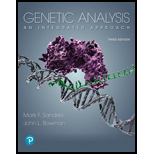
Concept explainers
Human ABO blood type is determined by three alleles, two of which (IA and IB) produce gene products that modify the antigen produced by protein activity of an independently assorting H gene. A rare abnormality known as the Bombay
Want to see the full answer?
Check out a sample textbook solution
Chapter 4 Solutions
Genetic Analysis: An Integrated Approach Plus Mastering Genetics with Pearson eText -- Access Card Package (3rd Edition) (What's New in Genetics)
- Mutations in the genes for clotting factor VIII and IX cause hemophilia A and B, respectively. A woman may be heterozygous for mutations in both genes, with a mutated factor VIII allele on one X chromosome, and a mutated factor IX allele on the other. All of her sons should have either hemophilia A or B. However, on rare occasions, one of these women gives birth to a son who does not have hemophilia, and his one X chromosome does not have either mutated allele. Explain.arrow_forwardThe XG locus on the human X chromosome has twoalleles, XG+ and XG. The XG+ allele causes the presence of the Xg surface antigen on red blood cells,while the recessive XG allele does not allow antigento appear. The XG locus is 10 m.u. from the STSlocus. The STS+ allele produces normal activity ofthe enzyme steroid sulfatase, while the recessive STSallele results in the lack of steroid sulfatase activityand the disease ichthyosis (scaly skin). A man withichthyosis and no Xg antigen has a normal daughterwith Xg antigen. This daughter is expecting a child.a. If the child is a son, what is the probability he willlack Xg antigen and have ichthyosis?b. What is the probability that a son would have boththe antigen and ichthyosis?c. If the child is a son with ichthyosis, what is theprobability he will have Xg antigen?arrow_forwardSeveral genes in humans in addition to the ABO gene () give rise to recognizable antigens on the surface of the red blood cells. The Rh marker is determined by positive (R) and negative alleles () of gene R, where R is completely dominant to r. The presence of M and N surface proteins are controlled by two codominant alleles of gene L (LM and LM. For each mother-child pair, choose the father of the child from among the males in the right column. (Assume that all mothers and fathers are HH; there is no involvement of the Bombay phenotype.) Paternal genotypes maybe used once, more than once, or not at all. Each mother-child pair matches with one or more than one paternal genotype. Maternal phenotype: Child phenotype: Paternal genotype: Reset A, M, Rh(neg) O, M, Rh(pos) B, N, Rh(neg) O, N, Rh(pos) O, M, Rh(neg) A, MN, Rh(pos) A, N, Rh(pos) AB, MN, Rh(pos) B, N, Rh(pos) A, MN, Rh(neg) Genotypes of possible fathers AiLMLN rr BiLMLN RR ii LNLN rr ii LMLM rr AALMLN RRarrow_forward
- Hemophilia A is caused by a recessive X-linked allele that encodes a defective form of a clotting protein. If a affected father and a mother who is known to not be a carrier have children, what percentage of female offspring will have hemophilia?arrow_forwardExplain why absence of agglutination in A and B does not fully conclude type O phenotype.arrow_forwardIn humans, the genes for red-green color blindness (R = normal, r = color blind) and hemophilia A (H = normal, h = hemophilia) are both X-linked and only 3 map units apart. Suppose a woman has four sons, and two are color blind but have normal blood clotting and two have hemophilia but normal color vision. What is the probable genotype of the woman? HR/hr Hr/hr hr/hR Hr/hR HR/Hrarrow_forward
- In 1952, an article in the British Medical Journalreported interesting differences in the behavior ofblood plasma obtained from several people who suffered from X-linked recessive hemophilia. Whenmixed together, the cell-free blood plasma from certain combinations of individuals could form clots inthe test tube. For example, the following table showswhether clots could form (+) or not (−) in variouscombinations of plasma from four people withhemophilia:1 and 1 − 2 and 3 +1 and 2 − 2 and 4 +1 and 3 + 3 and 3 −1 and 4 + 3 and 4 −2 and 2 − 4 and 4 −What do these data tell you about the inheritance ofhemophilia in these individuals? Do these data allowyou to exclude any models for the biochemical pathway governing blood clotting?arrow_forwardThe gene controlling ABO blood type and the gene underlying nail-patella syndrome are said to show linkage. What does that mean in terms of their relative locations in the genome? What does it mean in terms of how the two traits are inherited with respect to each other?arrow_forwardAchondroplasia is a rare dominant autosomal defect resulting in dwarfism. The unaffected brother of an individual with achondroplasia is seeking counsel on the likelihood of his being a carrier of the mutant allele. What is the probability that the unaffected client is carrying the achondroplasia allele?arrow_forward
- Could an individual with blood type O (genotype ii) be a legitimate child of parents in which one parent had blood type A and the other parent had blood type B?arrow_forwardWith regard to the ABO blood types in humans, determine the genotype of the male parent and female parent shown here: Male parent: Blood type B; mother type O Female parent: Blood type A; father type B Predict the blood types of the offspring that this couple may have and the expected proportion of each.arrow_forwardHemophilia A is transmitted by an X-linked recessive gene.With an affected father, what is the probability that a childwill have the disease? With an affected father and a carriermother, what is the probability?arrow_forward
 Human Heredity: Principles and Issues (MindTap Co...BiologyISBN:9781305251052Author:Michael CummingsPublisher:Cengage Learning
Human Heredity: Principles and Issues (MindTap Co...BiologyISBN:9781305251052Author:Michael CummingsPublisher:Cengage Learning Concepts of BiologyBiologyISBN:9781938168116Author:Samantha Fowler, Rebecca Roush, James WisePublisher:OpenStax College
Concepts of BiologyBiologyISBN:9781938168116Author:Samantha Fowler, Rebecca Roush, James WisePublisher:OpenStax College

